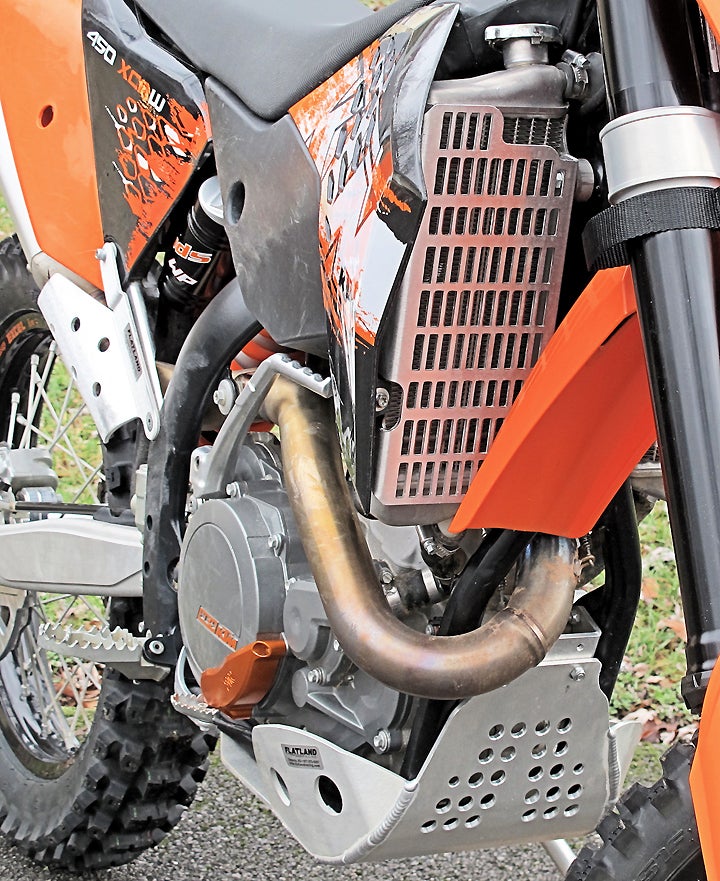
If you read my Body Armor 101 feature last month on DirtBikes.com, then you already understand the basics of protecting your body from the potential impacts that can be suffered during serious off-road riding. But what about your bike?
It’s no secret that off-road riding is murderous on a dirtbike. Whether your riding takes you across the open desert or through the densest of woods, there are bound to be rocks, roots and other nasty obstacles that seem only too happy to hammer and snag your motorcycle’s vulnerable parts, potentially causing catastrophic damage. So, in the same spirit as Body Armor 101, let’s focus on helping your dirtbike or dual-sport machine withstand the assaults of nasty terrain. Battle-readiness involves bolting on an assortment of armor plating to keep vulnerable parts of your motorcycle intact after impact.
Different environments present different challenges, so not all armor is necessary or appropriate for all situations. I’ve spent a lot of time crawling over rock gardens and slewing through slimy, rut- and root-infested eastern-style single-track trails. Falling is a routine event in such settings, and can vary from a walking-pace tumble onto large, jagged hunks of stone, to a sudden high-speed encounter with several closely spaced trees that only looked wide enough to slip between. The items shown here have, on many occasions, saved me from having to haul a broken bike out from deep in the woods. If your off-road adventures take you through loamy fields or desert dunes, you can probably get by with less coverage.
Engine Cases
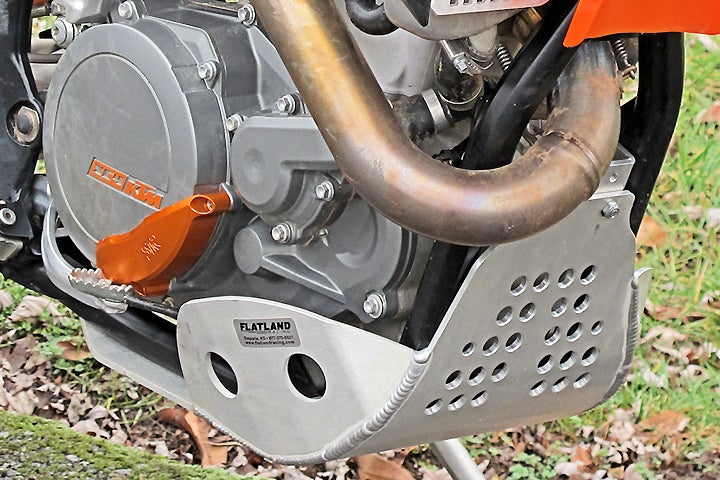
Perhaps the most important threat to address is a breach of your engine’s cases. Landing on a sharp rock can break through the sometimes surprisingly thin and brittle cast aluminum walls that keep oil in and debris out. This is not recommended. Case repair in the field, while occasionally possible with metal epoxy putty, is definitely to be avoided if at all possible. An ounce of prevention can be worth a ton of cure.
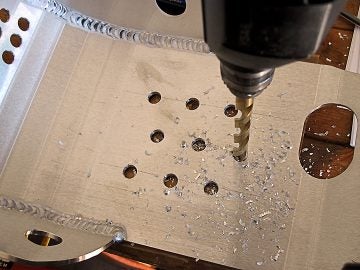
Skid plates provide a sturdy barrier between engine and earth, both directly underneath and up around such vulnerable essentials as water pumps and ignition stators. These can be made of aluminum, plastic, composite or carbon fiber, with widely varying weight and strength. Glide plates cover only the area between the lower frame rails, and are more appropriate for motocross tracks than wilderness.
When choosing, look for easy mounting/removal (some can be terribly awkward) and retained access to oil drains and sight windows. We tend to “add lightness” by drilling additional holes, which not only decrease the weight of these relatively heavy pieces, but also allow for more airflow and quicker water escape. Just make sure not to compromise the plate’s structural integrity with too many holes, or holes spaced too closely together.
Coarse, purpose-built skid plate foam prevents mud from caking between motor and armor, while allowing water to pass through the space. Also, consider replacing that big, fragile clutch cover with a billet version, or adding a layer of defense with a form-fitting billet or carbon fiber shield to at least protect it from puncture by the brake pedal.
Radiators
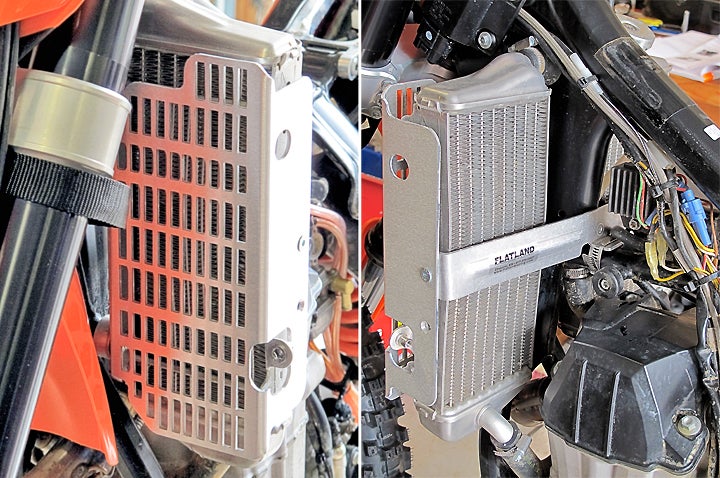
Only slightly less crippling than a broken case is a busted radiator. Sticking out far enough to access cooling airflow equals sticking out far enough to also be crushed in a fall, or pierced by a javelin-like branch. A seriously compromised cooling system means riding only very short distances at a time, and taking long breaks to allow the engine to cool. Comprehensive radiator protection includes a combination of a) screening the delicate cooling rails from the front, b) enclosing the outboard uprights, and c) bracing the entire structure. Some radiator guards perform all three functions, while others may have to be used in combination to achieve the full effect.
Brakes
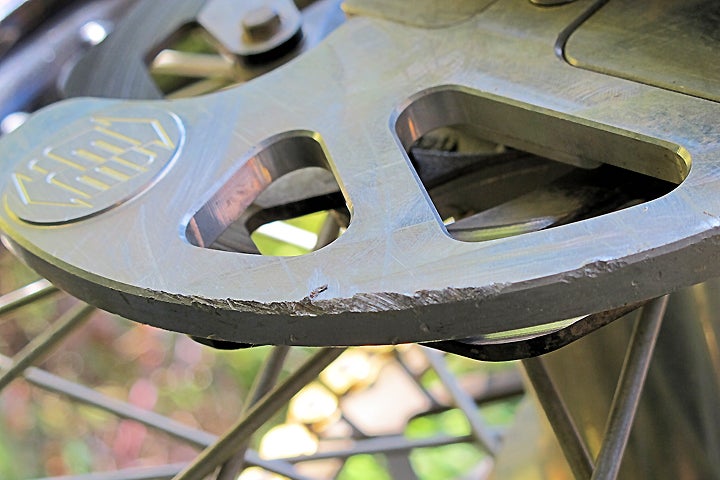
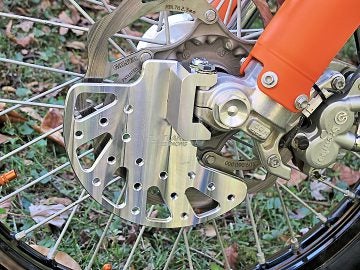
The ability to keep your wheels rolling is just half the recipe for making it out of the boonies; you also need to stop them before you reach those cliff edges and tree trunks. Brake rotors live right where rocks, roots and ruts are trying hard to grab your wheels, or at least deliver powerful glancing blows. A bent rotor will make your brakes work poorly, or prevent your wheel from turning altogether, and they are shockingly expensive to replace. Disk guards can be metal pieces that jut beyond the rotor’s lower edge, or they can be plastic shrouds that enclose the (front) rotor all the way around. We prefer the former; they’re much stronger and don’t block cooling airflow. Some rear guards will include a new carrier for the brake caliper.
While not exactly armor, a “brake snake” helps keep your rear brake pedal from getting bent outward by anchoring its tip to a lower frame rail. Designs vary, but these are basically just a short cable that runs through a hole drilled in the pedal and loops around a nearby stretch of frame. Make sure to leave just enough slack for full pedal movement. Options range from less than $10 to over $20; we see no advantage to spending more.
Clutch Slaves (cable clutches need not worry)
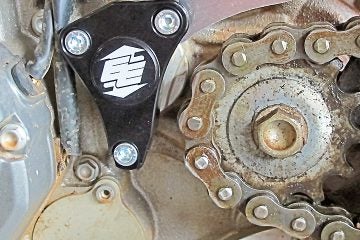
If you were an engine component, one of the scariest places to find yourself would be right next to the whirring chain and countershaft sprocket. These frenetic pieces not only promise destruction upon contact, but they drag all sorts of potentially hazardous junk around with them. Clutch slave cylinders are usually positioned immediately adjacent to the countershaft area, with only a flimsy plastic half-shroud between them and their toothy neighbor. While a clutch is arguably less essential for backwoods escape than the items already listed, many off-road situations are a nightmare to navigate without one.
Armor here usually includes a billet cover for the slave cylinder itself, along with a sturdy metal knockdown bar that will help limit a broken chain’s flailing around (which can be quite violent). A thick plastic slider (suspended above the chain’s upper rung over the swingarm pivot) may also serve to protect nearby parts from chain slap during extreme suspension compression.
Exhaust Pipes
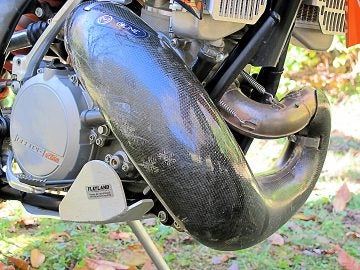
Bulky two-stroke expansion chambers hang awkwardly right behind the front wheel, where they’re certain to get hit with debris and/or sustain impact. Stock units are often made of fairly thin metal that is easily dented, and even small deformities in their precisely sculpted shapes can detract from engine performance. (Some aftermarket pipes feature much sturdier construction.) Form-fitting shrouds come in metal or carbon fiber, and greatly increase the life expectancies of the parts they cover.
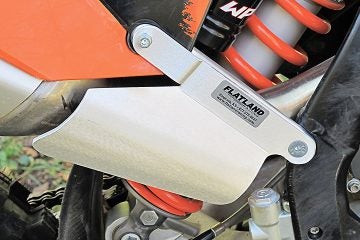
Four-stroke exhaust pipes are less vulnerable, and little dents have less effect on their engines’ power output. While guards are available to protect headers and extension pipes, they often have more to do with protecting riders from burns than shielding the exhaust system from impact. Four-stroke exhausts get much hotter than their two-stroke counterparts, and can melt synthetic pants and boot parts almost instantaneously. They’re even harder on flesh. It’s important to cover the section(s) most likely to make rider contact. Again, we like to improve airflow by drilling holes.
Handlebars
Wrap-around handguards, commonly referred to as “Bark Busters” (the name of their most well-known manufacturer), serve two purposes. First, they create a safe space for the rider’s hands by establishing a perimeter defense. Sensitive, fragile and highly useful digits are thereby shielded from potentially damaging impacts during falls, or while blasting through trees and brush. These pieces also protect hardware by bracing handlebars against bending, and by defending levers and master cylinders against breakage. Note that the protection offered by wrap-arounds is far more substantial than that provided by the stalk-mounted roost guards that sometimes come stock on dirt bikes.
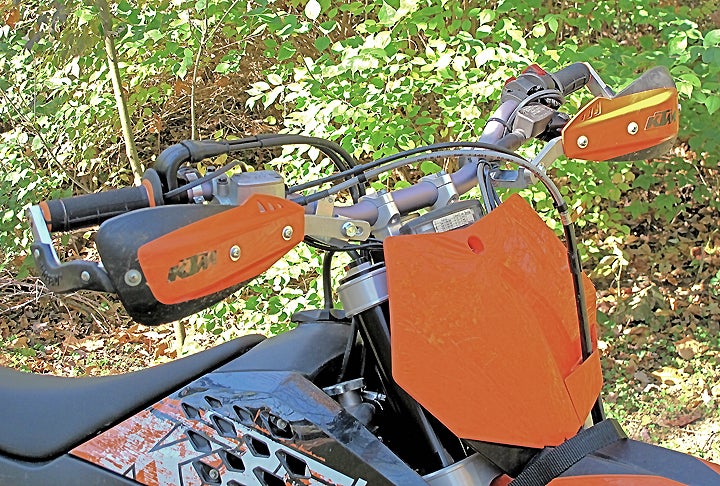
While most wrap-arounds mount via expanding tubes inserted into the handlebar’s ends and a pair of posts clamped onto the handlebar’s exterior, some brands (e.g. Fastway, BRP and Bonz) offer a design we consider superior. Instead of using clamp-on posts, the guards’ inboard ends are secured to rigid structures that replace the stock upper handlebar clamps. This further reinforces the bars against bending and prevents the guards from rotating upon impact, something the clamp-on posts may allow when hit at certain angles. Some manufacturers offer rotation-resistant mounts secured to the upper triple-clamp, but these are not compatible with bar risers (as used with a steering stabilizer sub-mount).
Plastic deflectors are useful additions to the basic handguard structure, which is just a narrow, rectangular-section bar of aluminum. Deflectors come in many shapes, sizes and colors, and block roost, brush and a little wind. They attach with small screws or brackets. Make sure they’ll fit your chosen brand of handguard.
Sample Costs
Protection comes at a price, in terms of both money and weight. I recently outfitted my 2008 KTM 450XCR-W with a fresh set of armor. Note that the brands listed below build high-quality armor that I’ve purchased and field tested with excellent results. However, this article is not meant as an endorsement of these over other manufacturers; they’re simply being used for illustration. Google the type of armor you’re looking for, and compare what’s available for your particular bike. Here’s what it cost:
Flatland Racing skid plate 3lbs., 10oz. (sans extra holes) $95
System Tech Racing clutch cover guard 1.4 oz. $72
MSR brake snake 0.4 oz. $10
Flatland Racing radiator guards 1 lb., 9oz. $95
Flatland Racing front disk guard 1 lb. $90
Enduro Engineering rear disk guard, with caliper carrier 1 lb., 3oz. $95
Enduro Engineering clutch slave cylinder guard 5 oz. $40
Flatland Racing exhaust heat shield 7 oz. (sans holes) $40
Cycra ProBend handguards, with plastic deflectors 2 lbs. (total for both) $110
BRP handguard mounts (substituted in above) 2 oz. (net added) $70
Total 10 lbs., 5.8 oz. $717
That’s a significant weight penalty and a hefty price tag, but compared to the cost of replacing the protected components and the anguish of having a disabled bike out in the middle of nowhere, we feel it’s a reasonable trade-off for this bike where we ride it.
What I’ve shown you here is the armor I’ve found most useful on my bike where I ride. Other kinds exist, such as metal cages enshrouding rear brake calipers, crash bars surrounding adventure bike engine bays, guards for rear suspension linkages, and composite chain guides to replace the metal (read: permanently deformed by impact) versions that come stock on many Japanese dirt bikes. Consider the vulnerabilities of your bike and the hazards where you ride when deciding how to protect your own assets.
Resources
Bonz Components
PO Box 108
Point Roberts, WA 98281
604-940-1047
www.bikebonz.com
NOTE: This is a Canadian company; US mailing address is shown here, but phone number is in British Columbia and will incur international calling charges.
BRP (Billet Racing Products)
3415 Fillmore Ridge Heights #B
Colorado Springs, CO 80907
800-834-9363
www.brpmoto.com
Cycra
171 O’Neill Drive
Hebron, OH 43025
800-770-2259
www.cycra.com
E Line Accessories
54 Spectacle Pond Terrace
East Wareham, MA 02538
508-295-0812
www.elineaccessories.com
Enduro Engineering
6081 South MLK Boulevard
Lansing, MI 48911
517-393-2421
www.enduroeng.com
Fastway Performance (now part of ProMoto Billet)
11461 Lone Star Road
Nampa, Idaho 83651
866-466-4762
www.promotobillet.com
Flatland Racing
628 Graham Street
Emporia, KS 66801
877-375-5527
www.flatlandracing.com
KTM (source for skid plate foam–see the KTM PowerParts catalog)
KTM World
1501 Culp Lake Road
Cedartown, GA 30125
770-748-0771
www.ktmworld.com
MSR (Malcolm Smith Racing)
1055 Montecito Drive
Corona, CA 92879
951-340-3301
www.msracing.com
System Tech Racing
5469 North Glade Road
Loveland, CO 80538
303-794-5095
www.systemtechracing.com
TM Designworks
PO Box 355
Phoenix, OR 97535
541-772-4161
www.tmdesignworks.com
 Your Privacy Choices
Your Privacy Choices